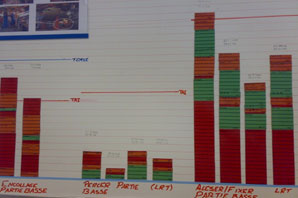- Manufacturer of leading brand of hard candy recently installed four bagging lines that had been shipped from another site
- Each line consisted of a bagging machine, display packing machine and a case packer. The first two lines had been commissioned and were now in production.
- Downtime of longer than 8 hours on some shifts, significantly affecting the supply chain, and the site was under huge pressure to meet its targeted outputs quickly.
- New technology and production equipment proved frustrating to initial problem solving team (relying on previous experience)
Initial Condition
- Each line was operating at less than a 33% of their capacity due to continual problems with the bagging machines
- Floor space planned to serve product preparation process appeared excessive
- No control of the bagging machine adjustments, therefore not obvious what had been adjusted or by how much
- B&N Europe was asked to coach the site team to increase output to achieve a minimum of 67% efficiency
Planned Activities / Intervention
- Was determined that Majority of downtime was due to excessive diagnosis time identifying the root cause to the problem
- Problem Solving team identified 6 main problems
- Team determined that line production was restricted by the processing speed of the scales
- Initial countermeasure was to optimize output while packing machinery was running, through adjusting scale settings
- Adjusted scale setting allowed for 11% increase in packing machine speed
- By increasing bag fill rate to 100%, downtime was reduced on the line across all shifts
- The team increased in output per shift by nearly 300%, while achieving efficiencies of 83%.
- By meeting the supply chain demand, additional capacity of 270,000 cases annually were freed up for further sales growth.
- Labor benefit of $808,000 annually as a result increase in efficiency
- Material saving benefit of $108,000 annually from the reduction in bag scrap




